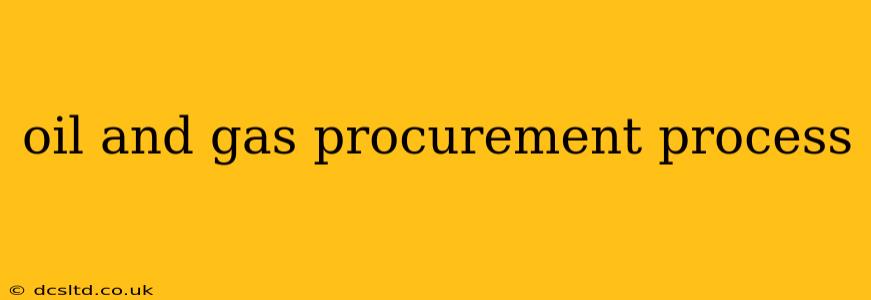The oil and gas industry is a complex beast, and its procurement process reflects that complexity. From exploration and production to refining and distribution, procuring the right goods and services is critical for efficiency, safety, and profitability. This guide delves into the intricacies of the oil and gas procurement process, offering a comprehensive overview for both industry insiders and those new to the field.
What is the Oil and Gas Procurement Process?
The oil and gas procurement process encompasses all activities involved in acquiring goods and services needed for operations. This involves everything from sourcing and selecting suppliers, negotiating contracts, managing contracts, and ensuring timely delivery to managing risk and compliance. It's a multifaceted process demanding meticulous planning, robust systems, and a deep understanding of industry regulations and best practices. The specific steps involved can vary depending on the size and nature of the company, the type of goods or services being procured, and the geographical location. However, certain core principles remain constant.
Key Stages in the Oil and Gas Procurement Process
The oil and gas procurement process can generally be broken down into these key stages:
1. Needs Identification and Planning
This initial stage involves defining the specific goods or services required, specifying quantities, quality standards, and delivery timelines. A thorough understanding of project needs is crucial to avoid unnecessary costs and delays. This stage often involves collaboration between procurement, engineering, and operations teams.
2. Sourcing and Supplier Selection
Once the needs are defined, the procurement team begins sourcing potential suppliers. This might involve searching existing supplier databases, conducting market research, or soliciting bids through competitive tendering processes. Supplier selection is based on various criteria, including price, quality, reliability, safety record, and financial stability. Rigorous due diligence is essential to ensure compliance and mitigate risk.
3. Negotiation and Contract Award
After identifying suitable suppliers, negotiations begin to finalize pricing, payment terms, delivery schedules, and other contractual obligations. Contracts are meticulously drafted to ensure clarity, protect both parties' interests, and comply with all relevant regulations. The process often requires specialized legal and technical expertise.
4. Contract Management and Performance Monitoring
Once a contract is awarded, the procurement team actively manages its performance. This includes monitoring delivery schedules, tracking quality, resolving disputes, and ensuring compliance with contractual terms. Regular communication with the supplier is critical for proactive issue management.
5. Payment and Invoice Processing
Upon satisfactory completion of the contract, payment is processed according to the agreed-upon terms. This stage involves verifying invoices, ensuring accuracy, and timely payment to maintain positive supplier relationships.
6. Performance Evaluation and Improvement
The final stage involves evaluating the supplier's overall performance and identifying areas for improvement. This feedback loop helps optimize future procurement processes and strengthens relationships with key suppliers.
What are the challenges in oil and gas procurement?
Managing Risk: The inherent risks in the oil and gas industry, such as environmental hazards and geopolitical instability, heavily influence procurement decisions. This necessitates robust risk management strategies throughout the process.
Global Supply Chains: Procurement often involves global supply chains, introducing complexities related to logistics, international regulations, and currency fluctuations.
Technological Advancements: Keeping up with technological advancements and integrating innovative solutions into the procurement process is crucial for efficiency and competitiveness.
Compliance and Regulations: The industry is heavily regulated, requiring adherence to strict safety, environmental, and ethical standards throughout the procurement process.
Sustainability Concerns: Increasing emphasis on environmental, social, and governance (ESG) factors is shaping procurement strategies, with a focus on sustainable sourcing and reducing the industry's environmental footprint.
How is technology changing oil and gas procurement?
Technology is revolutionizing oil and gas procurement through:
- E-procurement systems: Streamlining the entire process from requisition to payment.
- Big data analytics: Optimizing sourcing decisions and improving supplier relationships.
- Blockchain technology: Enhancing transparency and traceability in the supply chain.
- Artificial intelligence (AI): Automating tasks and improving forecasting accuracy.
The oil and gas procurement process is a complex but vital aspect of the industry. By understanding its key stages, challenges, and the impact of technology, companies can optimize their procurement strategies, improve efficiency, and mitigate risk. Effective procurement is not merely about acquiring goods and services; it's about building strong supplier relationships and driving operational excellence.
